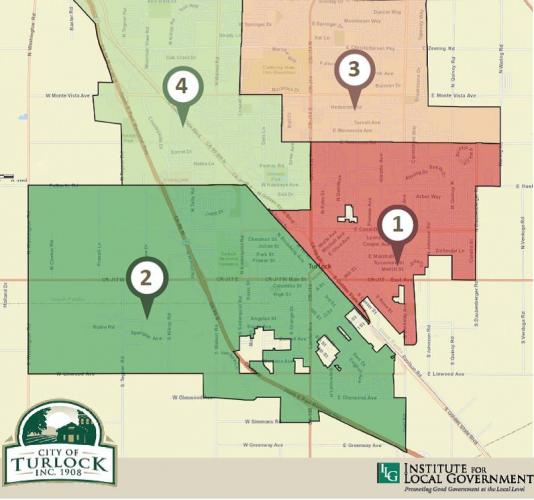City of Turlock District Elections
Community: City of Turlock (Stanislaus County)
Population: 70,365
Summary
Communities throughout California hold either at-large elections or district based elections. With the passage of the California Voting Rights Act (CVRA) in 2001, every community has an opportunity to elect candidates of their choice. The City of Turlock received a letter in 2013 from a local political community group warning of a possible CVRA violation. In response, the city council voted in June 2014 to put Measure A, a district elections measure, on the November 2014 ballot. A robust community outreach process was conducted by the city and its community partners. Turlock residents passed Measure A, approving a move to district based elections, by a large majority.
Program Highlights
- The city held workshops in each quadrant to share proposed district maps with the public in May 2014.
- The City Council approved the districting plan on a unanimous vote June 10.
- Community outreach activities conducted spring through fall
2014 included:
- Translating outreach materials into several of the native languages spoken by Turlock residents: Spanish, Portuguese and Assyrian.
- Featuring background election materials on the city website homepage for eight months.
- Distributing educational materials at the weekly farmers market.
- Leaving several hundred handouts with various local businesses for patrons to pick up.
- Inserting informational flyers in with the utility bill mailers thereby reaching thousands of residents.
- Conducting educational presentations to local civic groups / service clubs such as Turlock Realtors Association, 20-30 Club and the Latino Community Roundtable.
- Interviews conducted by Mayor John Lazar with the Modesto Bee linked here.
- Circulating educational materials across the city using door-to-door political campaign volunteers already mobilized by other political campaigns.
Lessons Learned
- Disseminating voter outreach and educational materials via trusted local community leaders and civic organizations spreads the word faster than the more traditional method of posting information at city hall.
- Educational materials can be widely circulated very efficiently when handed out by the door-to-door political campaign volunteers already mobilized by other political campaigns.
- Success is more likely when city leadership agree that for local government to be accountable to the entire community it serves, all voices must have an equal opportunity to be heard.
More to the Story
The City of Turlock has a large percentage of Latino residents, however with few exceptions; the city council has historically been of Caucasian origin. The city received a letter in 2013 from a local political community group warning of a possible CVRA violation. The CVRA is a law that was adopted in 2001 that seeks to ensure that every community has a fair chance to elect candidates of their choice. The city’s options included:
- Fight the potential CVRA lawsuit (which could be very costly). The City of Modesto settled a similar case in 2007 and was responsible for paying $4.7 million in attorney fees.
- Do nothing and hope the issue goes away.
- Voluntarily convert from at-large to district based elections.
The city held a series of public workshops in May to inform residents of the issue. Three potential district maps were proposed and residents were asked to vote for their preferred option. The map below was selected by residents and then later approved by city council.
Council voted in June to put Measure A, a district elections
measure, on the November 2014 ballot. The proposed plan created
districts with equal population in the southeast (District 1),
southwest (District 2), northeast (District 3) and northwest
(District 4) quadrants of Turlock. Council members would be
elected to four-year terms in Districts 2 and 4 starting in
November 2016. Districts 1 and 3 would be on the ballot in
November 2018. 
Some of the initial community apprehension centered on the perception that citywide planning concerns would be supplanted in favor of neighborhood issues thereby fracturing the city. Other issues included the cost of converting to district elections and the uncertainty of what would happen if nobody ran from a particular district. A robust community outreach process was conducted by the city and their community partners. Key elements of the outreach process can be found in the Program Highlights section above.
Turlock residents passed Measure A, approving a move to district based elections, by a large (74 percent) majority.

